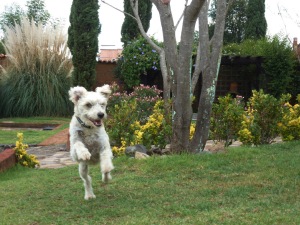Just as three years had passed since we were last in Patzcuaro, so too has it been that long since we were in Erongaricuaro, “place of waiting” in the Purepecha language. The two towns are close in proximity to one another, strung around lovely Lake Patzcuaro, so if we pet-sit in one, we tend to pet-sit in the other.
June is the start of the rainy season, but there have been plenty of warm, sunny days with only the occasional downpour. Nights are cooler, so much so that we sometimes hunkered down in front of a crackling fire and snuggled under thick comforters at bedtime. Meanwhile, at home in the interior of British Columbia, temperatures were soaring as high as 38 degrees Celsius. We had to keep reminding ourselves this was Mexico.
As in Patzcuaro, not much has changed in its smaller lake-side cousin. The place has always lacked a decent restaurant; the only food choices being the deep-fried taco stands lining one side of the plaza, the occasional cocina economica (economic kitchen) on the other, where you can sit at a plastic table and chair outside or in a small, dim entryway of the kitchen and eat cheap (but usually good, we’re told) sopa, tacos, burritos, etc. Sadly, nothing has opened in Testerelli’s old location, previously the source of the only good coffee and torta in town but, diagonally across the square, the new Doña Mary’s Restaurante serves excellent cappuccino for less than two bucks and a comida of chicken, rice and salad for about five bucks in a sectioned room creatively decorated with local art.
Down on what I call “the flats” (I don’t think anyone else does) — the fields and pastures demarcated by the canal that runs out to the lake — the sewage plant restaurant has closed (gee, I wonder why?) and two new ones have opened across the road, on the edge of the field. One is called Lupita’s, but it was always closed the few times we took a walk to check it out (found out later it’s only open on weekends), the other doesn’t seem to have a name. It’s setting was nice enough, however — ringside to the lush, green pasture, dotted with grazing cattle, stretching out to the lake — that we stopped in a couple of times, once just for drinks, another time for comida, a shoe-leather tough breaded chicken breast, and the ubiquitous rice and salad. On one other occasion, we ventured out to Campestre Alleman, the German restaurant on the way to Patzcuaro, again, mostly for the pastoral setting as well. The place is famous for its farmed trout, but the fish splashing around in the ponds these days are likely carp. We hear they now truck their trout in from Uruapan, Michoacan’s second largest city, about an hour’s drive away.
But enough about the food: we were here to reunite with friends Phyllis and Jon and their four-legged family. Sadly, Luna is no longer with us, but two new pups have taken up residence on the sprawling grounds. There’s Lucy the lab and Xochi the, uh, I dunno, honestly. She’s a Mexican mutt, I guess, but she’s a beauty: glossy black coat, copper eyes, long, graceful legs with grey and white-flecked boots. She has a thoroughbred’s prance and stance, and stretches nearly my height on her back legs.
Lucy’s still a puppy, which means endless reserves of energy and an obsession with chasing a ball. Xochi, being a former street dog, wasn’t so enthusiastic about things being thrown in her general direction (they’re usually rocks). After observing the goofy glee on Lucy’s face as she bounded after the ball, she quickly caught on and joined in. Lucy was always quicker, however, and never failed to trot by with the ball in her mouth, pushing her face into Xochi’s as if to say, “Beat you again, sucka!”
Rigo’s the same, i.e., still enthusiastically living up to his nickname of “Jack”. I think he’s actually worse this time. I mean, how do you keep your auto-erotica in check when sharing a home with two beautiful bitches? He’s still wild-mannered on walks, and Xochi and Lucy are not leash-trained. Walking them one at a time worked well, since they were out-numbered and actually came to feel special when it was their turn for an outing. Plus, since Xochi was a convicted chicken killer, having attacked at least three birds while free-walking, we just wanted to do our part for the local hen population.
Little Rocky is the same squeaker who spends most of her days skulking around inside, ever wary of an ambush, especially now that there are two new gangly dogs who don’t know quite what to make of her.
Cosmos is losing some of his killer instinct, bringing in only three lizards and one bird. Now that he’s an older gent, he seems to prefer lazing about to hunting.
Eronga’s “symphony of sounds” remains the same: barking dogs, booming fireworks, cacophonic garage-bands, and what I’m convinced is some kind of fight club across the field that starts up after dark. How else to describe hootin’ and hollerin’, and what sounds like body-slamming into metal walls and chain fences? Amplifying the ambience were the local elections that were taking place while we were here. Every other day, big rallies clogged the streets, candidates broadcasted their false promises via loudspeakers, and firecrackers blasted into the wee hours.

Leapin’ Lucy always catches the ball, much to Xochi’s chagrin. Click the pic for a slideshow of all the critters.
Eventually, when the polls closed, the politicos boarded their buses and blew out of town, when clubs and bands were resting their chops, and fireworks were mercifully dormant, a peace descended on the tiny town. It was then we’d venture out onto the lawn, this oasis of calm, dogs trotting eagerly behind, and we’d toss the ball, savoring the silence while this place of waiting held its breath.



























